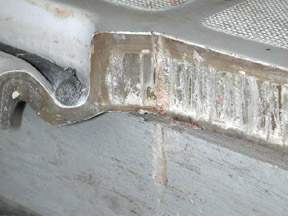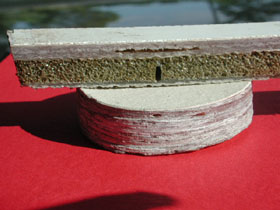Boat
show time is one of the few times we get to compare
many boats all assembled in one place. In the case of
the Ft. Lauderdale show at the Broward Convention Center,
we had the unique opportunity to see a gang of fish
boats all crunched together in one large room. There
were the Gradys, Contenders, Robalos, Centurys, Prolines,
Stamas', and Regulators all polished up and showing
their best.
Interesting split console design
And then there was Pursuit. What first attracted our attention was that the display was mobbed, attracting more attention than any other exhibit. True, the exhibit was nicer than all the others, and the boats clearly were polished up and gleaming better than the adjacent Grady-White boats on display.
But crowds and boats specially spruced up for a show is not what interests me; it's what lies under that tenderly polished gel coat, that we both know is going to look like a coat of flat white paint in a couple years, that interests me most. And the fact that S2 Yachts has moved their Pursuit line of boats into new territory, away from the well known Tiara style boat and into something to rival and compete with the higher end mini sport fishermen. The name Intrepid immediately comes to mind.
Side door entrance to head compartment.
The 3070 is a boat that comes in two styles, the open center console and the Offshore, which has what we might call a cuddy cabin, but is a bit more than that, and is rather similar to the Intrepid 30 CC. Both these boats, despite their size, are dedicated outboards and do not come with other power options. I instantly fell in love with the 3070 CC for a variety of reasons, the first of which is the sheer size, followed by the style and a wealth of practical considerations. Like the oversize console, which you would not be wrong if you called it a center deck house, for when you open up the door on the side you will see, what I knew was the inevitable evolution of larger and larger consoles . . . viola! a cabin inside. Actually, it's a head compartment and general storage room that is remarkably well finished off with a full inner liner.
Next, S2 designers seem to have a thing about tall windshields, and I'm glad they do, because on a boat like this, with such a fancy helm panel, the windshield is needed. Yes, while it is awkward looking and does detract from the overall line symmetry of the boat, that is a small price to pay for the protection from wind, spray and rain it offers, coming up within inches of the optional hardtop, but leaving a bit of room for ventilation.
Yet, ultimately, it is good engineering, quality materials and superior workmanship that leads me to call this boat the Best in Class. With a show price special tag of $141,700 hung on her, we compared this to the eye-popping price of the Grady-White Marlin 300 of $155,000 and I had to wonder if they didn't have the wrong tag on either one of these boats. That it was the Pursuits that were drawing the crowd was not hard to understand since, to merely outward appearances alone, these boats were leagues apart - the one greatly overpriced, the other a bargain for what you get.
Contrasting examples included such things as an integrated DC control panel that is water tight, that includes indicator lights for primary circuits that are energized, keyed on/off switches (for theft prevention, turn the power off and take the key with you), and external battery lugs on the outside of the box for ease of disconnection. That, compared to the other boat that has three battery switches located under a seat locker where they can get wet.
The main DC panel
Next up is the engine mounting. A pair of 250 Yamahas set an amazing 40" on center of prop shafts to allow for maximum low speed control, permitting control almost as good as a twin inboard boat. The engines on the other boat were but 24" apart and you can bet it will handle much like a single engine boat. We never understood why anyone would want to mount engines so close together. That's part of the reason why we end with boats that want to lay over on one side at higher speeds. You loose the stability when the trust is centered.
Props are a full 40" apart.
Again, the S2 line has the superior guard rails of hard vinyl overlaid with stainless edge banding as compared to softer rubber with a rubber center insert that you know what's going to happen to that: a year later it will be hanging like an abandoned clothes line. Like the days when GM glued moldings on the sides of cars and we'd see those wonderful GM vehicles going down the road with moldings flapping in the wind. Next we noticed recessed cleats on the Grady where the recess was so small that it makes it hard to get a line on the cleat. That's a big help.
The usual S2 non skid has been mercifully changed. The typical pointed diamond pattern has the tips of the diamonds removed so that the decks are no longer quite like walking on a rasp fuke.
The large cast Edson wheels are catching on with many builders, but S2 has always given you a large wheel, but they've changed from the usual stainless destroyer wheels to the faux Rybovich wheels by Edson. Has an interesting textured finish that should hold up well. Plus you can get it with a knuckle-knocker knob. I thought that was dumb, until I tried one. They're only dumb on cars, on boats they're great.
One thing disappointed me about this boat was the lack of foot coves. It only exists in a four foot section of the cockpit behind the console. Otherwise, you have those inward sloping liner sides that give you that awful sense of falling over because you don't dare rest your thighs on the gunwale and lean over. In addition to that, I got a sense of more useless space between the liner and the hull. But a closer look shows these spaces are not wasted, for there are a number of storage lockers built into those voids. That's cool for quick temporary storage for stuff like sunglasses and all those things you usually have no place to put on a small boat
The design of the bow seating is neat. Here, not only does the seat base lift up to yield storage beneath, but the seat backs also fold out for rod storage within. That's a heck of a lot better than attempting to store them under deck, or along the gunwales where they'll surely get damaged.
A first glance reaction at the faux transom area was, yuk! It's covered with Starboard on top and the forward face is as plain as the workbench in my garage. But then you realize, that's what this is . . . . a work bench for chopping bait or filleting fish. Then you realize that the lack of fancy detail is what is going to make cleaning up the resulting mess a lot easier.
On the technical side, the hull is cored on the sides as usual and SOLID glass on the bottom. Save the foam for coolers and insulation, I want some solid FRP between me and Davy Jones. Down below decks, the hull detail work is as good as ever with fully glassed plywood stringers and frames (plywood is best for the added strength it gives). Foam cored is fine, though it unnecessarily drives up cost. No "high tech" grid liners designed by CAD operators who haven't a clue as to what they're doing. Tried and true olde tyme methods that work is what we find here, so if you buy one, you're not the beta tester of a $141K product.
Also notably lacking was the post-molding repair of the gel coat finish that we found on so many boats on display. Under fluorescent lighting, patch ups in gel coat become glaringly obvious. You'd think that if they're going to put a boat in a show, it would be one of their finer examples that didn't require repair after it was yanked out of the mold. But then, most of the exhibitors were dealers, not the builders, so you know that what you see is what you get, warts and all. We didn't see any gel coat repair on any of the Pursuits. The disturbing aspect is that patch ups will discolor over time, leaving all that blotchiness that looks like repair of damage after the boat was purchased, but actually was done by the builder. This is but one of the things that distinguish quality from the run-of- the-mill boats, and why real quality costs more (in most cases).
 |
| Cross section of Nida Core in a Pursuit deck. Note the completeness of lamination even on these difficult to laminate corners, as compared with the typical sort of stuff found in lesser breeds. |
Nida Core has found it's way into the decks of all the S2 boats and that's good stuff. It's honeycomb of all plastic, so there's no deterioration problem whatever. In fact, the stuff is used for the cargo decks of airliners and helicopters. The Huey UH1H was the fist to use this stuff, and it's been doin' good ever since. It does, however, require a lot of skill to use the stuff right and the photo at left showing a deck cut up reveals that these folks know what they're doing.

These are deck cut outs from two "price" boats. The lack of quality is obvious with all the voids in the laminate.
The hull is a conventional V with no slots or any of that nonsense. Chine flats are fairly wide and the keel bottom is rounded back aft. Trim tabs are recessed. The deck is bonded together along with the inner liner and screwed together so that the screws are running through about 5/8" of material and not be prone to shearing, as most simple deck to hull joints are.
The attention to detail and the "little" extras are fairly admirable. One such is the stainless railing over and above the plexi windshield that prevents people from accidentally grabbing the plastic and breaking it. The console design exhibits the usual thoughtfulness but for the under panel switches which are bound to be frustrating. You've either got to stand on your head to see the labels, or memorize the switch positions. The upper panel is made for an array of flush mount electronics. The adjustable helm seat is far preferable in my view than the usual modified bolster types.
I suppose the console could be called a "split console" design, as it consists of a forward and aft part, the later of which facilitates not only the seating, but the tackle cabinet as well as providing the mounting for the optional T-top that gets most of the supporting bars out of your field of view.
I haven't begun to cover everything that could be said about this boat. If you're interested, I'll leave the rest for you to discover for yourself.









David Pascoe is a second generation marine surveyor in his family who began his surveying career at age 16 as an apprentice in 1965 as the era of wooden boats was drawing to a close.
Certified by the National Association of Marine Surveyors in 1972, he has conducted over 5,000 pre purchase surveys in addition to having conducted hundreds of boating accident investigations, including fires, sinkings, hull failures and machinery failure analysis.
Over forty years of knowledge and experience are brought to bear in following books. David Pascoe is the author of:
In addition to readers in the United States, boaters and boat industry professionals worldwide from nearly 80 countries have purchased David Pascoe's books, since introduction of his first book in 2001.
In 2012, David Pascoe has retired from marine surveying business at age 65.
On November 23rd, 2018, David Pascoe has passed away at age 71.
Biography - Long version